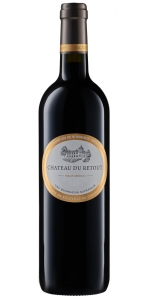Wine from Retout
The Phylloxera crisis at the end of the 19th century destroyed most of the French vineyards. Shortly after, the First World War, as well as the splitting up of properties due to inheritance laws, often led to the abandonment of winegrowing in general and even to the disappearance of some of the smaller wine estates.
This was the case with Château Retou-Rosset in Lamarque and Château Salva de Camino in Cussac Fort Médoc, both of which were classified “crus bourgeois”, as well as another estate, the “petit cru” Château Moulina. It was only in the 1950s, after their acquisition by the Kopp family, that these estates were brought back to life.
After a great deal of time and effort, the vineyards were gradually rebuilt. Today, this estate is still run by the Kopp family; daughter and son-in-law.
For many wine lovers or consumers, wine tasting is the preserve of professionals or real connoisseurs. People still have this image of it being a complex, technical, precise and highly-formalised process. In fact, wine tasting isn’t and shouldn’t be just that. No, it should be straightforward, convivial, interesting and fun. Tasting a wine should provoke curiosity, excitement, pleasure and dreams…
When you taste a Château du Retout wine, you use all five of your senses: the sense of touch when you pick up the bottle to gauge its temperature, the sense of hearing which allows you to enjoy the sound of he popping of the cork and the wine being poured into the glass, and then, of course, you use your senses of sight, smell and taste when you drink the wine:
The Médoc grape varieties and soils give us wines with superb, dense, dark hues, ranging from deep garnet to ruby-crimson, taking on brick red shades with orange tints with age.
Very intense and expressive aromas with powerful notes of black fruit such as blackcurrants and blackberries. In older wines, the nose develops a spicy bouquet of liquorice, leather and marshmallow mingled with the vanilla scents created by well-integrated oak.
Harmonious, elegant and velvety, with smooth, round tannins, that can be appreciated from the wine's entry to the palate through to the finish. These are delightfully full-bodied wines with great aromatic persistence.
Review:
"Shows the ripeness of the vintage, with dark currant and blackberry framed by singed cedar and vanilla. Ends with a tug of warm earth, a light twang of iron and a steady grip. Cabernet Sauvignon, Merlot and Petit Verdot. Drink now through 2034."
- Wine Spectator (TOP 100 wines of 2024), 92 pts and #45 on Top100
- back
Selected Options
Wineries
Categories
Pricing
Countries
Regions
Grape Types
Wineries
Organic/Free Shipping
Belle Glos Clark and Telephone Vineyard Pinot Noir is made from 100 percent Pinot Noir.
The Clark & Telephone Vineyard was established in 1972 and planted with “own root” Martini clone vines. Located just 13 miles from the ocean and situated on a west-facing slope, this vineyard experiences weather patterns that pull from west to east to bring cool fog and coastal breezes inland until August when Santa Ana winds begin.
We harvested early in the morning so the fruit would arrive at the winery while the grapes were still cool to preserve their vineyard-fresh flavors. After destemming (but not crushing) the berries, we cold-soaked the must for 14 days to soften the skins and allow for ideal extraction. During fermentation in a combination of closed and open-top stainless steel fermenters, we used both punch-down and pump-over techniques to extract color and phenolics. We aged the wine in 100% French oak (60% new) for up to 12 months. After the wine underwent malolactic fermentation, we racked it twice before bottling.
Deep ruby red in color with lush aromas of ripe cherry, nutmeg, dark chocolate and holiday baking spices. Bold and complex flavors of black plum, crushed raspberry and blueberry pie linger on the palate. The texture is rich and lively, and leads into a warm and structured finish.
Review:
Burnished black raspberry and graphite form a bond on a foundation of dark chocolate and sweet tobacco. White pepper outlines rose petal on the well-structured palate before perky acidity and a creamy weightiness highlight the lengthy finish.
-Tasting Panel 95 Points
Torello Corpinnat Finca Can Marti Brut 32% Chardonnay, 32% Xarel.lo, 22% Macabeo and 14% Parellada.
The Can Martí estate soils have been formed from sediments from the Garraf Massis, deposited thousands of years ago. One of the most characteristic features of the estate’s soils is the presence of accumulations of calcium carbonate.The movement of water through the soil dissolves the carbonates present and takes them to a certain depth. The continuous repetition of this process has ended up producing the accumulation of these deposits.When these become massive, after thousands of years, they bind together and and form a hard stratum called a petrocalcic horizon. This hard stratum limits the availbility of water to the vine and the production, but is a factor that gives the grape quality.
Straw yellow color, fine and constant bubbles, clean and bright, with golden reflections. The nose reveals a subtle aromatic intensity with fresh and sweet aromas. Honey flowers, citrus notes, white fruit, and balsamic herbs such as fennel.
In the mouth the acidity is well balanced, with delicate bitter notes to the finish and a set of ripe fruits and balsamic nuances.





